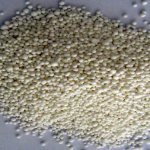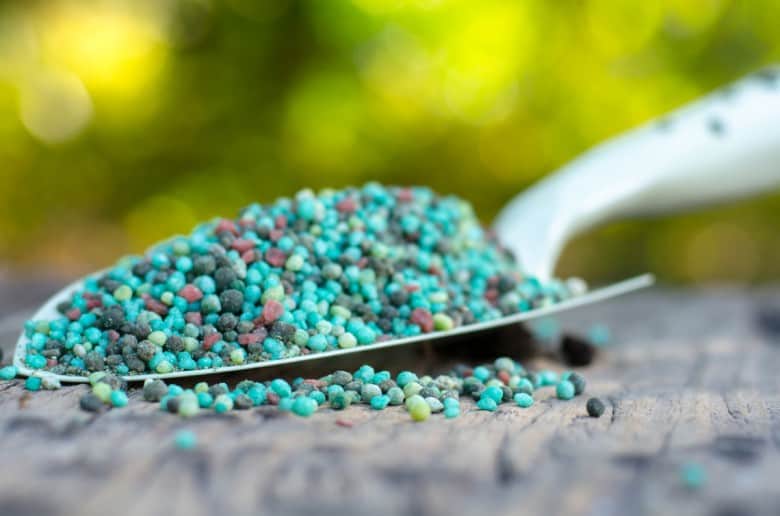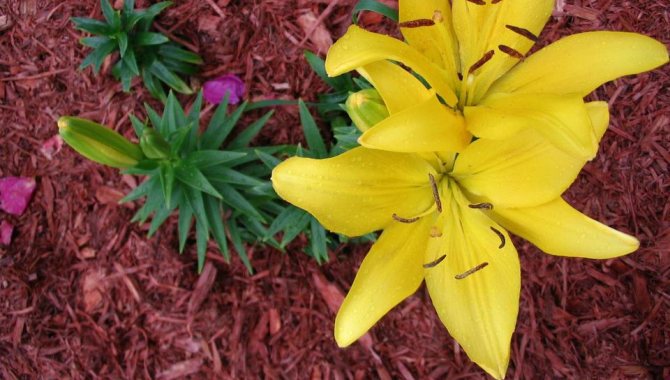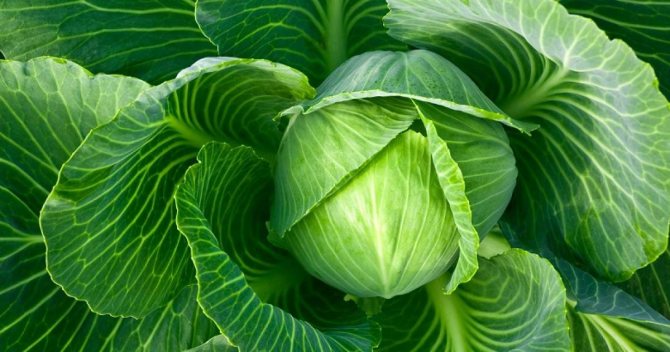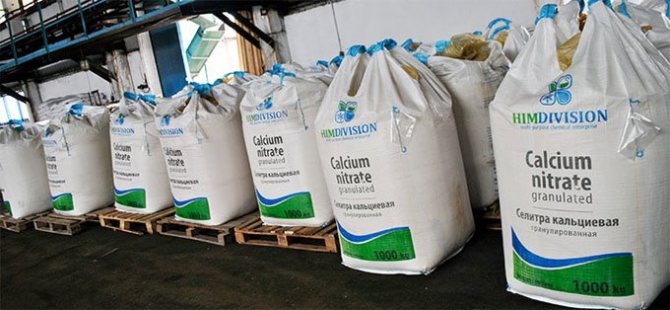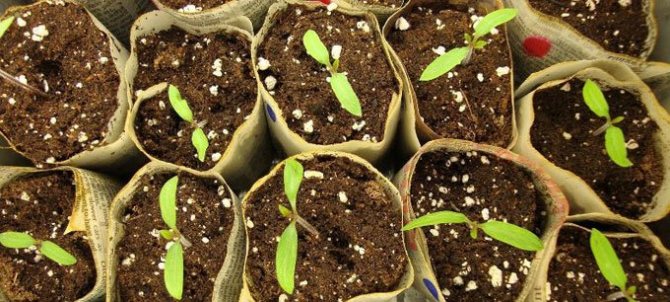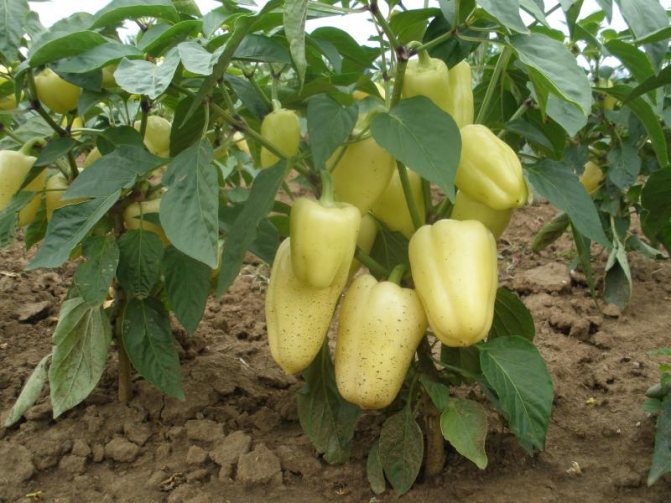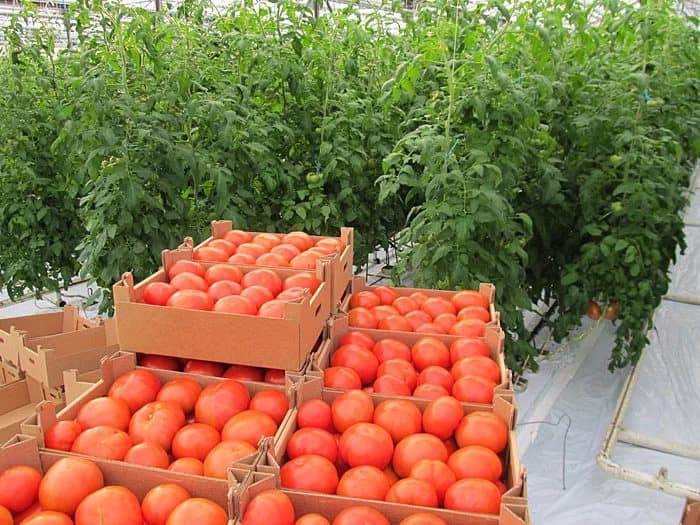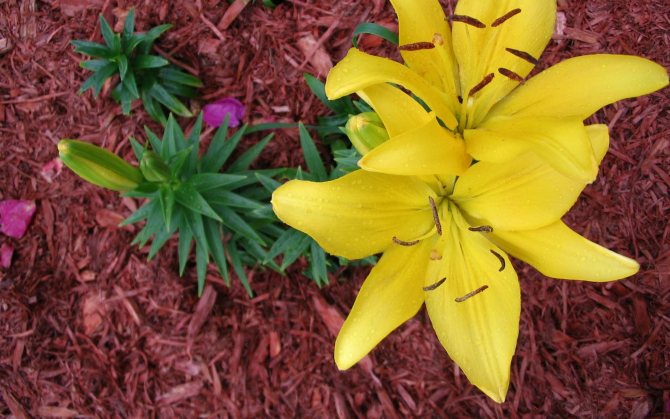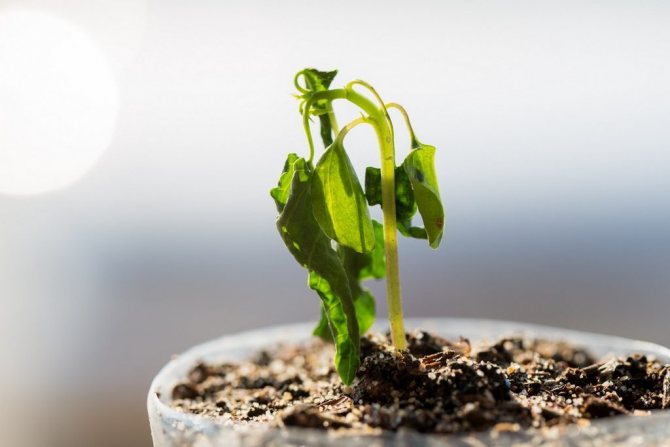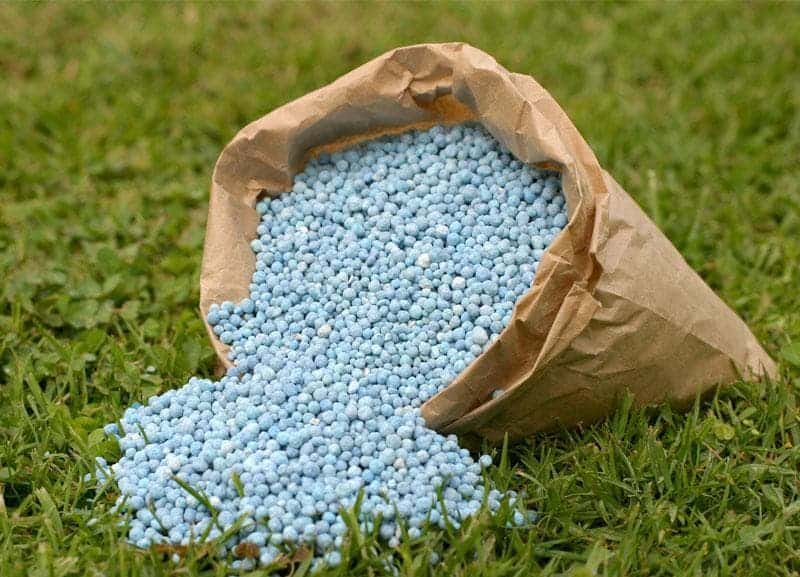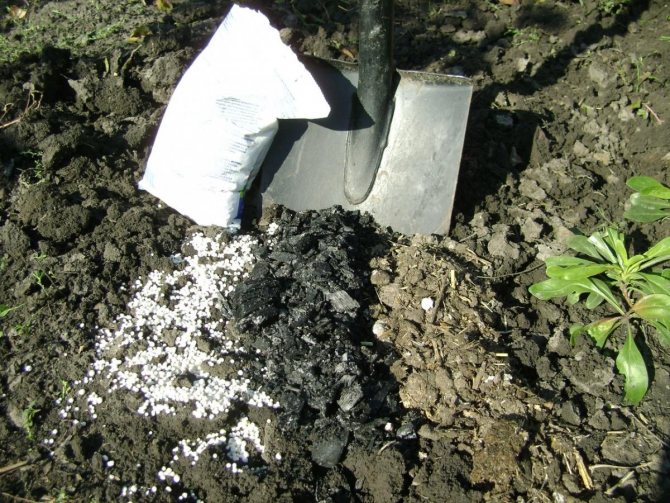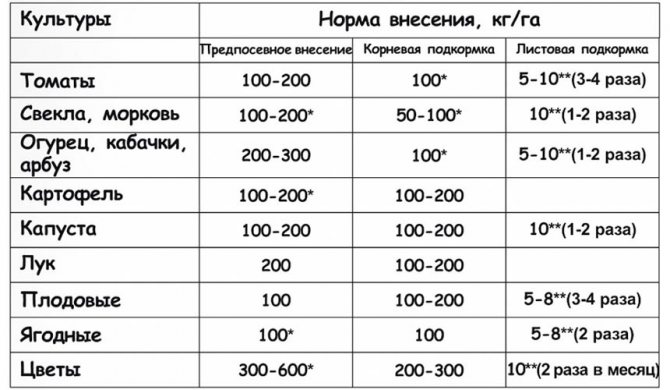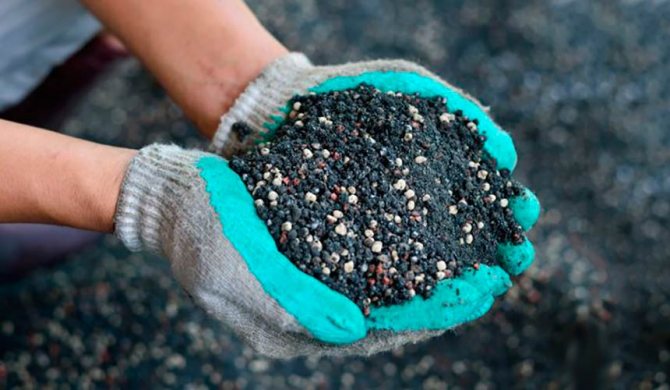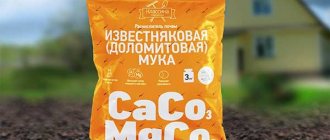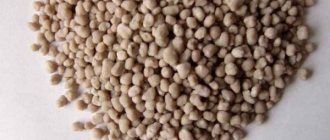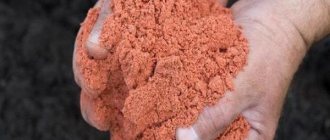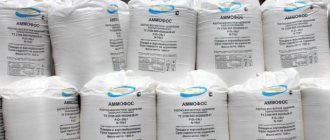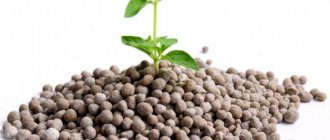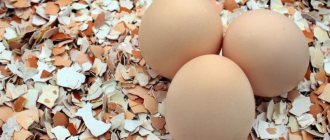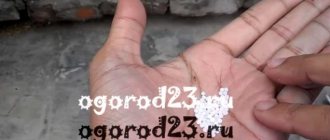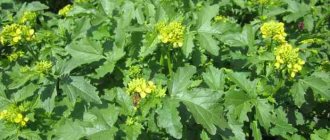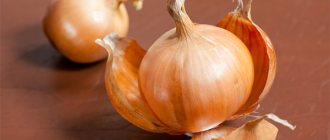Calcium nitrate has several names. Calcium nitrate, calcium nitrate - all this is it. Release form - crystalline salt, soluble in water. In agriculture, the use of calcium nitrate is practiced as a top dressing for seedlings, flowers and indoor plants.
Effect on vegetation
The fertilizer contains 19% calcium and 13% nitrogen. Such a composition helps not to oxidize the soil, does not harm the composition and fertility of the soil. The formula of nitrate Ca (NO3) 2, the composition includes trace elements that are effective for different types of soil, but especially for sod-podzolic.
Get such a composition as follows:
- Calcium nitrate is isolated from nitric acid and lime milk;
- By decomposition of phosphate with nitric acid compounds.
- In order to reduce the absorption of moisture from the environment, hydrophobic elements such as gypsum and paraffinic fuel oil are added to the composition.
There are 2 main types of fertilizers:
- From crystals - powdery;
- From granules - with a longer service life.
The first type is not very popular among consumers, since when applied, the dust scatters in different directions, which negatively affects the convenience of use, and sometimes health.
Calcium nitrate is very useful for vegetation in the initial and middle phases of the growing season, until the appearance of ripe fruits.
- Stimulates metabolic processes
- Accelerates fermentation
- Improves photosynthesis
- Increases resistance to disease and adverse weather conditions
- Increases productivity
- The fruits acquire a more attractive appearance, the structure of the pulp is improved
Calcium nitrate is used as a "nitrogen diet" for cultivated plants, during which the vegetation begins to gain green vegetative mass at an accelerated rate.
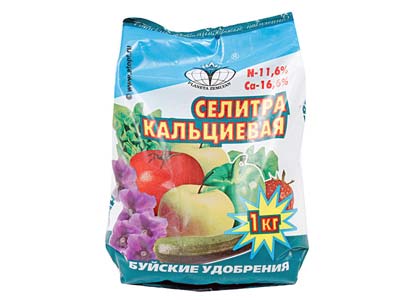
Now let's talk about the use of fertilizers in the garden.
Calcium nitrate is used only during the warm season. In the fall, the earth is not fertilized with this bait, since during the winter cold season all the nitrogen of the nitrate will be pressed out of the fertile horizon of the earth.
On the basis of calcium nitrate, both dry and liquid chemical fertilizers are prepared. The groundbait can be applied in open ground and in solid wood, and in each hole separately.
- Open ground processing. The spring soil, which has moved away from the winter frosts, is cleared of weeds and last year's tops. Calcium nitrate is evenly planned over the surface of the site at the rate of 20 (g) per 1 (m2). The soil is dug to a depth of 20-25 (cm).
- Planting seedlings. 2 (g) calcium nitrate is poured into each well. As a guideline, 2 (g) nitrate can be equated to half a teaspoon. Nitrate feeding of plants is lightly sprinkled with the ground to exclude direct contact with the rhizome. Everything, you can plant seedlings.
Please note that if the land was previously fed with calcium nitrate (for digging), then you do not need to fertilize the seedlings separately.
- Nutrient liquid for root bait. Calcium nitrate can be safely used as a life-giving solution. Here are the instructions for using the fertilizer. To prepare the nutrient fluid, you will need the following ingredients:
- Calcium nitrate (25 g)
- Boric acid (1 g)
- Irrigation water (10 l)
Saltpeter is diluted in a bucket of water.Boric acid is added to the consistency. The solution mixes well. The nutrient liquid can be fed to any vegetable beds, as well as shrub trees in the front garden and ornamental vegetation in street beds.
Watering is carried out at the rate of 0.5-1 liter for each unit of vegetation.
Liquid fertilizer for the garden can be used several times per season. The first time the vegetation is fertilized at the very beginning of the growing season (stage 2-3 leaves). After 2 weeks, the procedure can be repeated, but boric acid is no longer added to the solution.
Calcium nitrate goes well with many vegetables, berries and fruits. They react especially favorably to calcium nitrate: potatoes, beets, tomatoes, cucumbers, cabbage and salad greens. The use of fertilizers in the garden will also be advisable when feeding sunflower with corn.
Also, they will not refuse calcium nitrate: strawberries, grapes, raspberries, apple trees, cherries, currants and other and other crops.
Calcium nitrate or calcium nitrate is an inorganic salt of nitric acid. Chemical formula - Ca (NO3) 2.
Pure calcium nitrate is a crystalline, water-soluble white powder.
For use in plant growing, calcium nitrate is produced in the form of small granules or powder, which resembles ordinary salt in crystal structure. For use on a personal plot, a granular form is preferable, since it is convenient to use: it is less hygroscopic and does not become dusty when applied.
What is calcium nitrate for (click to open)
Calcium nitrate promotes the formation of cell membranes, serves as a building material for the formation of cell walls. The principle of operation is based on the complementarity of the main elements. Nitrate contained in nitrate promotes absorption of calcium and potassium ions by plant cells. Calcium, in turn, is responsible for the absorption of nitrogen by the roots and its transport to other parts of the plant. Lack of calcium leads to nitrogen starvation even with sufficient nitrogen content in the soil.
Composition and properties of nitrate nitrate
What is calcium nitrate made from? The agrochemical is obtained as a by-product after the separation of nitric acid from ammonia, as well as during the decomposition of phosphate raw materials. To obtain granules, ammonium nitrate is used.
Calcium nitrate - formula Ca (NO3) 2.
Crystalline nitrate is less convenient to use, as it is more susceptible to moisture. Recently, a granular form of calcium nitrate has been used in agricultural production.
Inexperienced gardeners often neglect the use of calcium nitrate in their practice, relying on other agrochemicals. However, one should not forget that calcium is directly involved in the process of assimilation of nitrogen from the soil by plants. Nitrogen is included in the structure of other agrochemicals as an essential fertilizer substance, but its assimilation depends on a sufficient calcium content in the soil.
Agronomists advise adding calcium to acidic soils, it neutralizes excess manganese and iron compounds. This promotes better vegetation, better ability of the roots to absorb moisture. Due to poor moisture absorption, the roots can rot and the culture will disappear. Timely introduction of calcium nitrate into the soil will save the day.
Benefits:
- has a beneficial effect on the root structure;
- increases the yield of the plot with fruit and vegetable crops;
- favorably affects flowers and shrubs;
- protects seedlings from diseases;
- packaged in small packages.
Also, saltpeter improves the quality of the fruit and increases the shelf life of the crop. Thanks to calcium nitrate, crops are resistant to adverse weather conditions and are less susceptible to bacteria attack.Saltpeter promotes the growth of seedlings, activating the formation of cells and metabolic processes in plants, stimulates photosynthesis and improves the taste characteristics of fruits.
Calcium nitrate is an irreplaceable fertilizer for summer cottages and vegetable gardens, its beneficial effect has been proven by many years of experience in the agricultural sector.
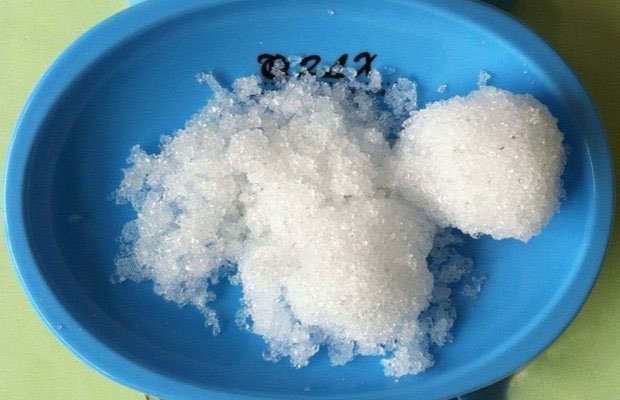

Description
The composition contains about 19% calcium and from 13 to 16% nitrogen in the nitrate form. The substance practically does not acidify the soil, which compares favorably with urea and a number of other nitrogen-based mineral fertilizers.
Calcium is not an essential element of the NPK complex, but at the same time it is necessary for plants to fully assimilate nitrogen. For areas with acidic soils, this is perhaps the best fertilizer.
Lack of calcium is reflected primarily in the development of the root system, which ceases to fully absorb nutrients and moisture from the soil and may eventually start to rot.
In appearance, calcium nitrate is a crystalline powder or white granules. In practice, the latter are much more efficient and easier to use. Among the features - good solubility in water, long-term preservation without loss of properties (provided the package is tight).
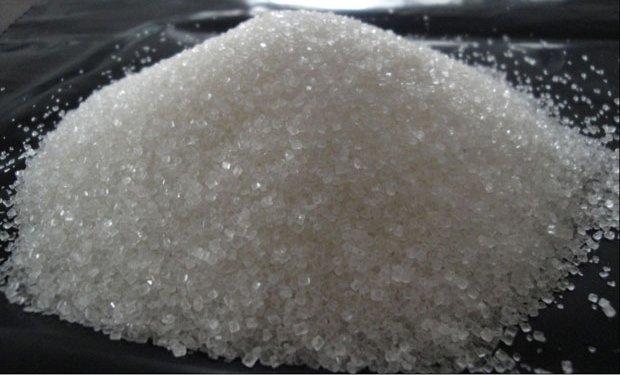

This feeding improves the processes of photosynthesis and accelerates the development of plants (both root and ground parts). Treated crops tolerate temperature extremes well (perennials winter better), become less susceptible to pest attacks, fungal, bacterial and viral diseases. The share of the output of marketable products is increasing, the terms of its storage increase. The total yield can increase by 10-15%. Calcium nitrate, added to the soil before planting, accelerates the germination of seeds and tubers.
With all the above advantages, the drug should be used strictly according to the instructions, observing the application rates and terms for a particular culture. Most often, this fertilizer is applied to the soil during the spring digging of the site. There will be practically no sense from the introduction of calcium nitrate during the autumn digging. The fact is that when the snow melts, nitrogen will be washed out of the ground and only calcium will remain in it.
Properties
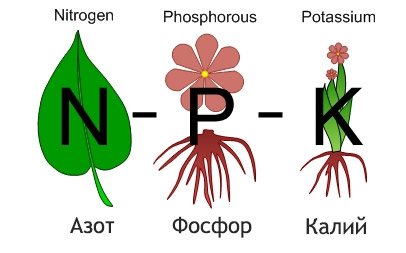

Many gardeners often neglect the use of calcium nitrate when fertilizing their area. Yes, calcium is not part of the NPK complex, which contains vital substances. But at the same time, it is calcium that helps to fully assimilate nitrogen, the main substance from the NPK composition - a complex that ensures active growth and development of all plants.
Another very important property of calcium nitrate is that it is considered the best fertilizer for acidic soils. This fat has a revitalizing effect on plants, contributing to their high-quality vegetation, as it absorbs from the soil excess manganese and iron, metals that are contained in sour soils in large quantities.
Lack of calcium affects primarily the root system. She stops getting the required amount of nutrients. The local balance is disturbed, the roots cease to absorb the moisture supplied to them, and rot. After this has happened, the entire plant may die. To avoid negative consequences, it is necessary to make this top dressing in a timely manner.
In the instructions for use, which is attached to fertilizers containing calcium nitrate, it is said that they must be applied in the spring, for digging the soil. In autumn, it is absolutely not worth using this fat, since all the nitrogen contained in it will be washed away during snow melting, and only calcium will remain from a balanced complex of useful elements, which is not very useful without nitrogen, and most often it is simply harmful.
Over the past few years, calcium nitrate has been produced in two forms - granular and crystalline. Since the crystals of this salt are highly hygroscopic, if there is a choice, it is better to acquire a granular form, which is much easier to handle, does not generate dust during application, and absorbs less moisture from the surrounding air.
What is the value of fertilizer?
Do you have calcium nitrate in your fertilizer arsenal?
Well no
- Promotes the development of green stems and leaves, as it has a beneficial effect on plant cells during photosynthesis;
- Calcium contributes to the complete assimilation of nitrogen by plants;
- Activates enzymes that promote rapid seed germination;
- Forms healthy, strong roots;
- Neutralizes the harmful effects of bacteria, fungi, various diseases;
- Strengthens perennial plants, contributing to their frost resistance;
- Allows any plant to grow well and bear fruit well;
- Plant fruits have a longer shelf life;
- Promotes good metabolic processes during the growth and ripening of fruits;
- Improves the richness of the fruit taste.
The importance of calcium for plants and signs of calcium deficiency
Lack of calcium leads to a deterioration in the commercial quality of the fruit. Even with a satisfactory appearance and taste, the shelf life and transportability of the crop can be reduced.
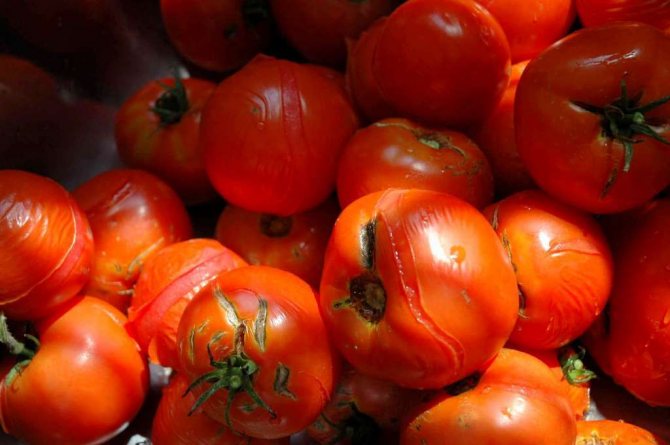

Rotten tomatoes
With a lack of calcium, the plantings show signs such as:
- the tops of the plant shrivel and dry;
- whitish spots appear on the foliage;
- ovaries dry and fall off;
- plant growth slows down.
Top dressing by leaf
- Calcium nitrate can help when growing cabbage even at the seedling stage. For 1 liter of water, take only 2 g of mineral dressing. Watering is carried out strictly at the root, avoiding contact with young stems and leaves. When planting seedlings on a plot, granules (1 tsp without top) are introduced directly into the planting holes, after which they are sprinkled with a layer of garden soil (the roots of the seedlings should not come into direct contact with the concentrated fertilizer).
- Before the beginning of the flowering period, strawberries and strawberries are fed with a nutritious mineral solution. In 10 liters of water, 25 g of calcium nitrate are diluted.
- Fruit trees and shrubs are fed until the budding phase. Dissolve 30 g of the drug in 10 l of water.
- The rest of the vegetable crops, which are tolerant to calcium, are fed before flowering with a less concentrated solution (20 g of nitrate per 10 l of water).
In no case do not combine the introduction of calcium nitrate and simple superphosphate. These mineral fertilizers are incompatible with each other.
Application of calcium nitrate solution on the leaf prevents or slows down the wilting of plants, decay of the root system and fruits.
First of all, foliar feeding with this fertilizer is useful for cucumbers. The first application is made as soon as the third leaves are formed on the stems. Further, observing an interval of 10 days, regular application is continued until the phase of active fruiting. Dissolve 2 g of the drug in 1 liter of water. This treatment prevents the development of rot in the root zone.
They are fed with calcium nitrate and tomato seedlings planted in a permanent place (about a week later, after full adaptation in a new place). The product will prevent the appearance of apical and black rot on plants, as well as protect bushes from slugs, thrips and spider mites.
By the way, since calcium nitrate has the property of accumulating in the tissues of tomatoes for a certain period of time, even after stopping the treatment, the positive effect of protection will persist for some time.
Vegetable, berry and flower crops should be sprayed at the rate of consumption of 1 - 1.5 liters of working solution per 1 m2. About 2 liters of liquid top dressing are spent on shrubs.
Strictly follow the instructions when choosing the concentration of the working solution for a particular culture.
Calcium nitrate is also good for flower crops. It helps them to form a healthy green mass and at the same time prevents the development of rot.
A solution of calcium nitrate (2 g per 1 l) prevents phlox peduncles from shrinking. Fertilizer is applied on the leaf as the first (starting) top dressing, repeated after 10 days.
This remedy will also help petunias in the seedling phase. To prepare a working solution, 1 tsp is diluted in 1 liter. saltpeter. As a result, the plants become more vigorous, the fragility of leaves and stems quickly disappears. After planting in a permanent place, the petunia is fed again, this time at the root (use the same concentration of the nutrient solution).
And finally, I note that for individual use it is more convenient to buy calcium nitrate in packages of 1-2 kg.
Flower food
Calcium nitrate is one of the best flower fertilizers. This mineral dressing helps to solve two of the most basic problems - high-quality formation of green mass and protection from rot. In fact, both annual and perennial flowers grow towards the middle of the season and begin to touch the ground.
After watering, wetting forms in this place, which then develop into putrefactive formations. This creates a favorable breeding ground for pests, which significantly spoil the appearance of the plant. The use of calcium nitrate helps fight this phenomenon. Penetrating into the stems, it increases their resistance to negative factors, sanitizing the plant and protecting it.
Perennial phloxes are one of the most common flowers throughout the Russian Federation. They are unpretentious, require little maintenance, and look very impressive in color. But, despite the fact that these flowers are undemanding, if they are not fed, the peduncles become smaller and lose their decorative qualities. Calcium nitrate is applied by phlox as the first top dressing of the season, in the form of a solution, twice, with an interval between dressings of 10 days. For its preparation, calcium nitrate is dissolved in water in a proportion of 2 g per 1 liter. Then it is used for foliar dressing.
Also, calcium nitrate is used to feed the pet of many flower growers in the middle strip - petunias. A solution of this fertilizer (1 tsp per 1 liter) is used for seedling a flower to strengthen its fragile "skeleton". After all, one of the main negative factors that interferes with high-quality cultivation of this plant in the open field is the fragility of leaves and stems.
Your favorite fruit and berry culture
Plants love calcium baits. Their inflorescences enlarge, the leaves and stems become strong and powerful. The bulbs form large, with enough storage substances, which is good for flower cultivation.


The most successful people in vegetable growing are people who love nature, have a special vision of the most insignificant changes in plant life, are able to evenly distribute physical activity, and patiently do their work.
All these qualities are possessed by Oleg Ivanovich Pomidorkin - an active person, a graduate, a true expert in his field. But the work of a vegetable grower, like any other work in agriculture, requires, in addition to knowledge of the specifics of growing and caring for plants, physical efforts.
It is necessary to be able to loosen the soil, weed plantings, add soil, work with fertilizers, prepare vegetable seeds for sowing. Then sow them with vegetable seeders or manually, lime the soil.
At present, Oleg Ivanovich applies the knowledge accumulated over 43 years of practical activity on his site, which he has been successfully engaged in for more than 10 years.
Are there any peculiarities in use?
In addition to acidic soils, such fertilizer can be successfully introduced into sandy soils, while it is worth applying diluted fertilizer in small doses and often, since the sand quickly passes moisture, preventing the root system from catching on useful trace elements of the fertilizer.
But in clay soils, you can apply all the necessary dose of fertilizer for feeding. The roots will absorb all useful microelements and begin to develop and strengthen successfully.
If a wide range of mineral fertilizers was previously used in the soil, then calcium nitrate will help neutralize the effect of excess trace elements.
Calcium nitrate for tomato apical rot
A sign of this disease is the appearance of a watery spot on the top of the tomato, which eventually becomes brown and thickens. Top rot can be caused by:
- lack of calcium in the soil;
- irregular watering;
- contact of fruits with the ground;
- bacteria.
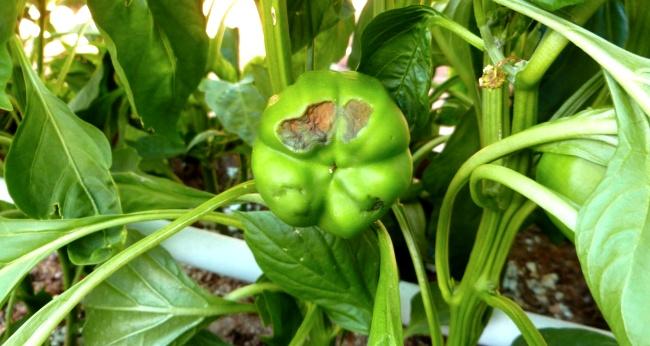

Top rot appears on tomatoes with dark spots on the fruit
Sick tomatoes should not be eaten. Timely feeding with calcium nitrate prevents the occurrence of this disease, since calcium increases plant resistance to diseases and helps maintain water balance.
How do plants show calcium deficiency?
A number of factors will help to understand that feeding the crops growing on your personal plot is simply necessary:
- Young leaves of the plant begin to fade, turn yellow and die;
- Older leaves may remain green;
- Some leaves may have yellow spots;
- Older leaves become large and change color not dark green;
- The leaf is deformed, the edges are bent;
- The plant practically stops growing or grows extremely slowly;
- Fruits also reduce growth;
- The fruits may not fully ripen and fall to the ground;
When to use calcium nitrate?
Experts recommend applying this fertilizer in early spring, as nitrogen will retain its qualities and will be absorbed by plant roots along with calcium. If fertilizer is scattered in the fall, the nitrogen will evaporate. The feeding properties will completely change, which can negatively affect the growth and development of vegetation.
Therefore, knowledgeable gardeners recommend sprinkling saltpeter in early spring - on the almost melted snow. The second stage can be carried out after the snow has melted by pouring granules onto the soil surface and digging up. Then the soil will be supplied with the necessary microelements and will become as fertile as possible for planting. This will be a root top dressing.
Foliar dressing is also needed to ensure good plant growth.
Nitrogen and calcium fertilizers
The importance of nitrogen fertilization for horticultural crops is difficult to overestimate - nitrogen is included in the structure of vegetable protein. Nitrogen deficiency leads to the fading of the growth and development of seedlings, to their premature wilting and death. Nitrogen is involved in the process of photosynthesis, without which a culture cannot grow and form leaves. Most nitrogen is contained in chernozems, the minimum percentage is in sandstones.
Signs of a nitrogen deficiency:
- leaves of plants become smaller, turn yellow and wither;
- the green massif is becoming rare;
- the fruit ovary dries up and falls off;
- the plant stops growing;
- young growth does not appear.
These signs indicate a lack of nitrogen in the soil. So it's time to add calcium nitrate.
With nitrogen starvation, cabbage leaves become transparent and turn yellow. With a strong nitrogen deficiency, the leaves do not roll into a head of cabbage and turn red. In a tomato, the leaves acquire a pale green tint, reddish veins are visible on the back.
Nitrogen deficiency in cucumbers leads to a weakening of the stem, yellowing of the leaves and the absence of fruit ovary. In beets, the leaves take on a pale yellow appearance and wither quickly. Bell peppers and eggplants form yellow leaves that are ready to fall off at any moment.In fruit trees, nitrogen starvation is expressed in the yellowing of the leaves of the lower branches.
An excess of nitrogen is also harmful to plants, they can die. An overabundance will be indicated by too juicy foliage, small fruits and a weak ovary structure. In this case, calcium nitrate cannot be added.
Nitrogen fertilizer is combined with calcium, which helps plants absorb it. Calcium plays an equally important role in plant and fruit health. Strong and correct formation of the root system, the course of vital processes and the taste of ripe fruits depend on it. Calcium ions ensure the absorption of nitrogen from the soil.
Note! Calcium plays an important role in the formation of juicy and tasty fruits.
Thanks to calcium, the fruits form a strong skin that helps protect against pests and gray mold. Also, calcium strengthens the stalk, which firmly holds the ripe fruit on the tree, and provides intracellular fluid exchange.
Diseases from lack of calcium:
- bitter rot on apples;
- premature spoilage of fruits;
- cracking and small fruit;
- sunburn.
Note! Calcium fertilizers are not recommended to be combined with the use of straw, sawdust and peat.
It is not recommended to exceed the dosage of calcium fertilizers, as they are nitrate and can accumulate in fruits.
Let us consider in detail the composition and application of calcium nitrate - calcium nitrate.


What crops should be fertilized and when?
The application volumes and the amount of the drug are adjusted depending on the cultivated crop, the agricultural technology used, the quality of irrigation water, the degree of acidity and other agrochemical parameters of the soil, as well as the weather conditions of a particular climatic zone. Before use, you should follow the manufacturer's recommendations indicated on the packaging of the drug.
| Cultures | Application rate | ||
| Presowing application, g / m2 | Root dressing, g / m2 | Foliar feeding, g / 10l of water | |
| Tomatoes, peppers | 10-20 | 10 | 1-2 (2-3 times per season) |
| Cucumbers, zucchini | 20-30 | 10 | 5-10 (1-2 times) |
| Potatoes | 10-20 | 10-20 | Not entered |
| Root vegetables (carrots, beets) | 10-20 | 5-10 | 10 (1-2 times) |
| Cabbage | 10-20 | 10-20 | 10 (1-2 times) |
| Onion garlic | 20 | 10-20 | Not entered |
| Berry | 10 | 10 | 5-8 (2 times before the beginning of fruiting) |
| Fruit | 10 | 10-20 | 5-8 (3-4 times before fruiting) * |
| Floral decorative | 30-60 | 20-30 | 10 (during the entire growing season with an interval of 2 weeks) |
| Lawn grass | 25 | Not entered | 40 (monthly) |
* For shrubs, 1.5-2 liters of working solution are consumed per bush, for fruit trees from 2 to 8 liters per tree, depending on age.
Calcium nitrate is consumed in different doses, using different methods for different crops.
Cucumbers
Foliar dressing is applied:
- When the 3rd leaf appears on the greens;
- With an interval between dressings of at least 10 days;
- When the fruits begin to appear more actively, feeding stops;
- The solution is prepared in proportions of 7 grams per 3 liters.
This treatment contributes to the elimination of rot in the root zone.
Tomatoes
A week after planting seedlings in the ground, they begin treatment with saltpeter, which:
- Prevents top rot;
- Strengthens the root system;
- Protects against harmful insects and mites.
It is worth fertilizing before the start of active fruiting, then the plant will be strong, and the fruits are fragrant, large and tasty.
Compatibility with other fertilizers
Compatibility is good, with the exception of simple superphosphate, calcium nitrate cannot be added with it. It is also not recommended to mix with potassium chloride and limestone. The rule of compatibility is simple - if there is already calcium or nitrogen in another fertilizer, then its excess in the soil will negatively affect the plants. Do not use stimulants or pesticides.
Together with saltpeter, you can choose other fertilizers - with a completely different composition, for example, phosphate rock, potassium sulfate.
Outcome
The widespread use of calcium nitrate makes it easier to care for garden plants, trees and flowers. This agrochemical increases the resistance of horticultural and ornamental crops to adverse conditions and temperature extremes, pests and diseases.
Calcium nitrate provides high-quality photosynthesis, the formation of lush greenery and flowers. When fertilizing fruit and vegetable crops, the palatability of plants, yield and storage duration increase. The yield increases by about 18-20%.
However, an oversupply of fertilizer can negatively affect the quality of the crop - the green massif will become lush at the expense of the size of the fruits. Also, an excess of calcium nitrate accumulates in the fruit part of plants, which harms humans. In this regard, feeding is stopped during the ovary of fruits - only at the beginning of the growing season.
It is necessary to store the agrochemical in a closed place out of the reach of moisture. Since calcium nitrate is a highly flammable substance, you need to protect the bags from fire and strong heat. When working with nitrate, individual safety measures should be taken - to protect hands with gloves, and the respiratory tract with a respirator.
How to prepare fertilizer yourself?
For the preparation of nitrogen-calcium dressing, you can use ammonium nitrate and slaked lime. There are several stages of fertilizer preparation:
- We light a small fire away from buildings;
- We put 2 bricks;
- We put an aluminum pan into which we pour 500 milliliters of water;
- We put on gloves on our hands;
- The respiratory organs are protected with a respirator;
- Pour 300 g of ammonium nitrate into a saucepan;
- Bring the mixture to a boil;
- Add 150 grams of slaked lime;
- We boil until the smell is lost (20-25 minutes);
- Let it cool until a precipitate is formed;
- We pour everything into a separate container, except for the sediment - the fertilizer is ready.
Homemade saltpeter
How to make calcium nitrate yourself? There is no difficulty in this. Mix 300 grams of ammonium nitrate with half a liter of water in a three-liter saucepan and put on fire. When the mixture begins to boil, add slaked lime (140 g) in small portions. You need to add lime slowly so that the process takes at least half an hour.
The mixture will smell strongly of ammonia, but then this smell will disappear. At this point, remove the pan from the heat and let the mixture sit. Lime will begin to precipitate in a dark tone - wait until it has formed. Then carefully pour the light solution into a separate bowl - you have got calcium nitrate. Then it is used to feed greens in accordance with the instructions.
Since you are dealing with a chemical, you must wear rubber gloves and a respirator mask. The pan must be taken from aluminum, the mixture is cooked in the open air. To make an improvised stove, take two bricks and light a fire from wood. Set the pot on top of the bricks and cook the saltpeter.
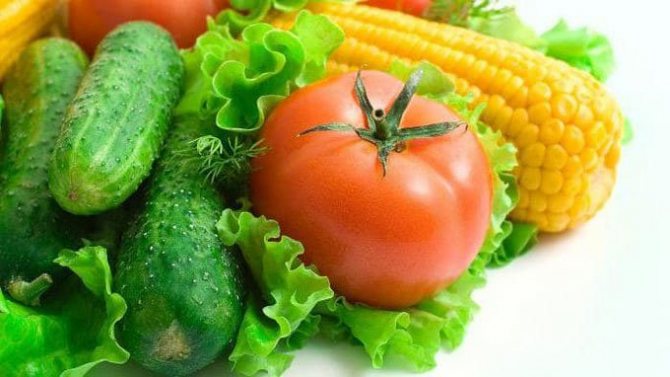

Minuses
This fertilizer belongs to the third hazard class, since its high concentration is dangerous for humans and harmful to soil and plants. Therefore, strict adherence to the instructions for use will avoid burns and poisoning.
When used correctly, this substance is absolutely safe.
But if substances get into the eyes, then it is urgent to rinse them with fresh running water. If vapors enter the organs during breathing, it is recommended to drink plenty of fluids. If negative symptoms appear, then calling a doctor is the only correct decision.
Read the instructions, properly dilute the powder and granules, observe the concentration and dosage, then there will be no danger for you and your plants. An excess of this fertilizer can lead to burns of the soil and plants, a decrease in fertility and the presence of nitrates in the fruits.If you follow the instructions, then the vegetation of the personal plot will delight its owners with yield and beauty.
Useful Tips
Difficulties in the cultivation of pepper are faced not only by beginners in the gardening business, but also by experienced farmers. Tips and general guidelines will help you avoid mistakes and grow healthy bushes. After all, only strong plants are able to bloom profusely, form an ovary intensively, and give a high-quality crop of the correct shape.
How to avoid phosphorus and potassium deficiency
Since nitrogen is not able to independently provide a normal metabolism, the plant must receive all the necessary elements during the growing season. Phosphorus and potassium are responsible for the formation of inflorescences and ovaries, as well as for the formation of fruits. The lack of the former is indicated by the purple tint of the leaf plates. At the seedling stage, seedlings are fed with superphosphate, a simple form of which contains up to 20% of the required chemical element. And if the shoots began to acquire a reddish color, this is evidence of a lack of potassium. Immediately after identifying signs of starvation, "Kalimagnesia" is introduced.
Determination of the lack of nitrogen and magnesium
The deficiency of nitrogenous compounds is visible immediately: there are few fruits, the foliage darkens and wrinkles, with prolonged starvation, plantings may die. A deficiency of magnesium, which is important for the normal development of plants, is indicated by yellowing and curling of the leaves. To avoid unpleasant signs, nitrogen in the form of calcium nitrate is introduced during pre-sowing soil treatment.
It is important to observe the timing and dosage, since the excess is also harmful to the pepper: the growing season (before ripening) increases, and the fruiting period is reduced, the vegetable crop becomes vulnerable to diseases.
General recommendations
The positive effect of dressing comes only if the rules are followed. Basic conditions for the use of calcium nitrate:
- lack of chlorine in the working solution;
- strict adherence to directions for use and dosage;
- correct combination;
- careful use of the drug - the ingress of nitrogen in a high concentration on the foliage can lead to burns.
Efficiency of use according to reviews of gardeners
The fertilizer is sold in packaging from 20 g to 1-2 kg, convenient for gardeners.
Agrochemical features of the use of calcium nitrate:
- stimulates the development of the suction zone of the root system;
- improves metabolism;
- activates the process of photosynthesis;
- increases resistance to negative weather influences;
ALL the benefits of calcium nitrate (push to open)
- reduces the risk of fungal and bacterial diseases arising against the background of calcium deficiency (brown flesh of potatoes, bitter pitting of apples, subcutaneous spot of pome crops, apical rot of peppers and tomatoes);
- improves the taste, presentation and keeping quality of vegetables and fruits;
- helps to prevent losses during transportation, prolongs the shelf life of fruits;
- normalizes the acid-base balance of the soil.
As a result of the use of calcium nitrate, the yield of vegetables and fruits increases by 10-15%.
Svetlana: “If the soil is acidic, the cabbage will definitely hurt. The addition of calcium nitrate prevents keel formation. The main weed in my garden is wheatgrass. This means that the soil is slightly acidic. Therefore, I applied fertilizer when planting cabbage directly into the hole. The result is better than she could have hoped for. All the seedlings took root and went into growth together. We will be trying early cabbage soon ”.
Advantages and disadvantages of the drug
Used in horticulture and horticulture, calcium nitrate as a mineral supplement has positive characteristics:
- stimulates the growth and development of plantings;
- increases the immune forces of cultivated crops;
- increases productivity indicators by 10-15%;
- does not have a toxic effect;
- neutralizes acidic soils;
- improves the taste and marketability of the crop;
- prolongs the shelf life of vegetables, fruits.
The main disadvantage of this fertilizer is the detrimental effect on the underground part of horticultural crops and leaves. But negative consequences in the form of root or apical rot are possible with incorrect or untimely use of the mineral composition. If you adhere to all the recommendations specified in the fertilizer instructions, these problems can be avoided.
Calcium nitrate can be replaced with wood ash, which is used to dust the beds, or a working solution can be prepared from 10 liters of water and 10 ml of calcium chloride with the addition of calcium gluconate (10 tablets).
Methods for using calcium nitrate
Calcium nitrate is applied both in dry form and in dissolved form in any convenient way:
- scattering at the end of winter over the snow, with the melting of which the granules are dissolved by melt water, and the fertilizer falls into the ground;
- into open ground during the main processing;
- in the planting holes when planting seedlings;
- scattering along the surface of the soil, followed by loosening the row spacings;
- by watering the root zone;
- by spraying the solution over the sheet.
If calcium nitrate has already been introduced when digging the soil, there is no need to additionally pour fertilizer directly into the planting holes.
| Method of application | Procedure | Approximate application rates |
| When processing open ground | Distribute the fertilizer evenly over the surface of the site, dig up the soil to a depth of 20-25 cm | 20 g / m2 |
| When planting seedlings | Place the fertilizer at the bottom of the planting hole, sprinkle with earth to avoid direct contact with the roots | 2 g per well |
| Root top dressing | Water the pre-moistened soil with the solution in the root zone or along the perimeter of the trunk circle, finally shed the soil with irrigation water | Up to 10 g per 1 liter of water |
| Foliar dressing | Spray the aerial part of the plant with a working solution from a spray bottle until the leaf is completely moistened | 5-10 g / l of water |
General characteristics of fertilizer
The fertilizer reaches users in the form of granules or crystals. Both the one and the other version of the drug are perfectly soluble in water. Therefore, during storage, do not allow the product to come into contact with liquid. Many gardeners find pellets more convenient to use. They do not crumble and there is no need to be afraid of calcium dust getting into the respiratory system.
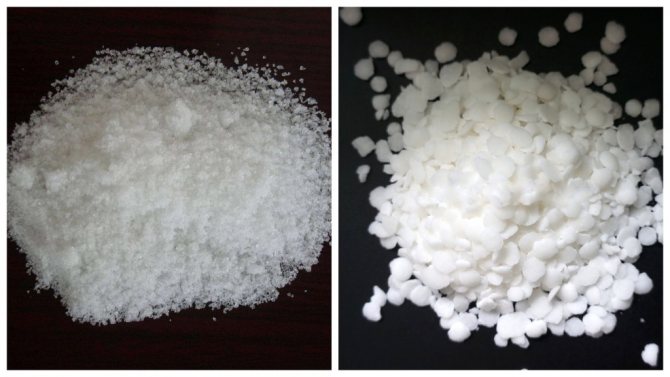

Calcium nitrate in crystals and granules
Principle of operation and results of use
So what is calcium nitrate fertilizer? It is a compound of chemical elements necessary for horticultural crops: calcium nitrate contains 19% calcium and 13% nitrogen.
Calcium helps nitrogen to penetrate into the plant cell sap. It is nitrate nitrogen, which is necessary for the health of the crop and the correct formation of fruits, that is absorbed better than nitrogen in the formulas of other fertilizers. This is especially true on acidic and slightly acidic soils, where plantings experience nitrogen starvation.
Saltpeter is the only fertilizer that can not only nourish the soil with useful components, but also improve its performance: it reduces acidity.
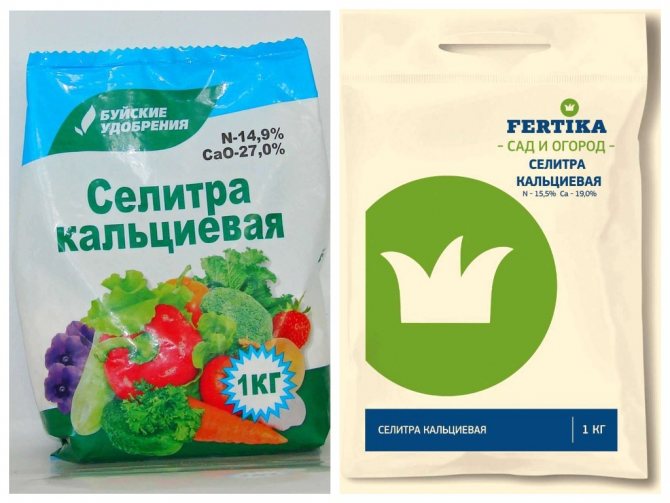

Calcium nitrate
As a result of the action of fertilizer, the nutritional quality of the soil increases, and the production of chlorophyll is accelerated. When applied in the garden in spring, saltpeter primarily optimizes the soil. It absorbs excess magnesium and iron, which inhibit the growth of plantings. Calcium nitrate prevents the penetration of harmful salts and metals into the structure of the plant, promotes the movement of carbohydrates.
Experienced plant breeders note the high resuscitation abilities of the drug. In addition, the use of calcium nitrate leads to:
- building up the green mass of the plantation;
- fast ripening of fruits and good keeping quality;
- correct development of the root system;
- good and friendly seed germination;
- low susceptibility to changes in climatic phenomena;
- increase in productivity (more than 15%).


Healthy plants in the garden
Forms for introduction into the ground
Calcium nitrate is a crystalline substance. Its introduction into the ground is possible in dry form (in a hole, when digging). Most often, the drug is used in a dissolved form. This is watering and spraying plantings with a solution of calcium nitrate in water.
It is important to remember that calcium nitrate is completely useless when applied to the soil during autumn digging. The fact is that nitrogen will be washed away with melt water, and the main goal - to provide cultivated plants with this necessary macronutrient - will not be achieved.
Types of dressings
In farmland, in private gardens and home floriculture, two types of dressings are used:
Root dressing... This means applying the fertilizer directly to the root. For this purpose, the agent can be used in crystalline form (1 tsp. Directly into the hole, crumbles during digging) or as a solution for watering growing crops. Fertilizer dosage is strictly individual for each crop.
The bulk of the crops are fed with the agent dissolved in water.
Saltpeter is not compatible with simple superphosphate.
Foliar dressing... This means spraying the plantings with a calcium nitrate solution. Landing processing has two goals:
- prevention of leaf wilting and root rot;
- building up green mass.
For example, the average consumption of the solution (25 g per 1 liter of water) for ornamental plants is 1.5 liters per m2, and for shrubs, 2 liters are enough for each plant.
These dosages are indicative. When working, you need to rely on the instructions for use of the drug.
Precautions when working
Subject to the rules for working with chemicals, calcium nitrate is not dangerous to humans. And if the concentration is exceeded, you can get a chemical burn of the mucous tissues. It is strongly recommended to wear rubber gloves and a mask before work. If nitrate dust gets into the respiratory tract, then urgently rinse your mouth and throat with running water and consult a doctor.
Storage rules
Like any chemical, calcium nitrate should be stored in an airtight container (preferably in a factory container) away from children, strangers and pets. There is no requirement for the outside air temperature, but the room must be dry.
For private households, buying a large package is not reasonable, because an open package cannot be stored for more than 6 months.
What plants can not be used for
Plants that prefer acidic soils do not need calcium fertilizer. Moreover, it will harm their growth and development.
These plants are:
- conifers of trees;
- fern crops;
- all types of hydrangeas;
- azalea;
- heather shrubs;
- northern berries.
Lovers of slightly acidic soil (viburnum, barberry and others) also need not be fed with calcium nitrate.
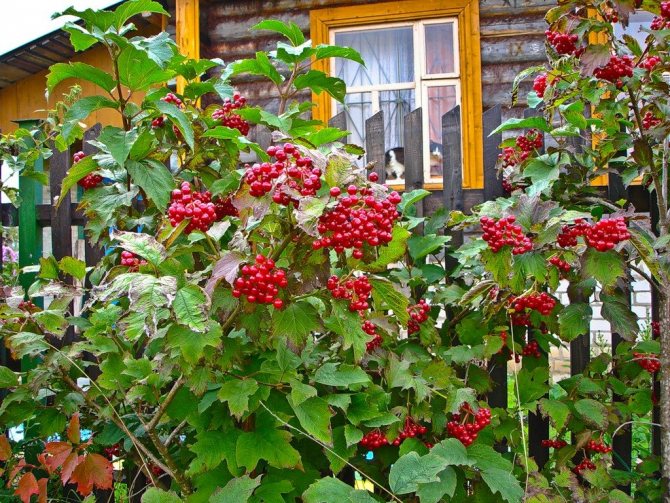

Viburnum bush
Calcium nitrate when growing seedlings
Root feeding with an aqueous solution of calcium nitrate stimulates the seedling during its germination.
Considering the short period of growing seedlings of cucumbers and cabbage (no more than a month before placing in the ground), with the first feeding it is necessary to give the plant more nitrogen for an accelerated set of vegetative mass. Seedlings of such crops as peppers and tomatoes, on the contrary, are waiting for planting for 2-3 months. The amount of nutrient mixture in seedling pots is limited, and the need for nutrition increases in proportion to the green mass gain by the plant.
Calcium nitrate must be added to the seedling mixture at the rate of ½ teaspoon per seedling pot.
The second time the seedlings are fed after the picking, in order to reduce the stress from the transplant and stimulate further plant growth.
| Culture | Spraying time |
| Cucumbers, zucchini, pumpkins | During the formation of the second or third true leaf, then with an interval of 7-10 days until the onset of mass fruiting |
| Tomatoes and peppers | When carrying out a pick, then 5-7 days after landing on a permanent place in the ground |
Zucchini seedlings are fed with a solution of calcium nitrate at the stage of the appearance of the second true leaf.
The dosage recommended for adult plants is approximately halved when feeding seedlings.
Spraying seedlings during the first week after placing them in the ground protects tomatoes from being affected by apical rot, late blight, as well as from the invasion of pests: thrips, ticks, slugs. After such treatment, a prolonged effect is observed - the immunity of plants remains high for a long time. Ripening tomatoes are not affected by black rot.
Precautions
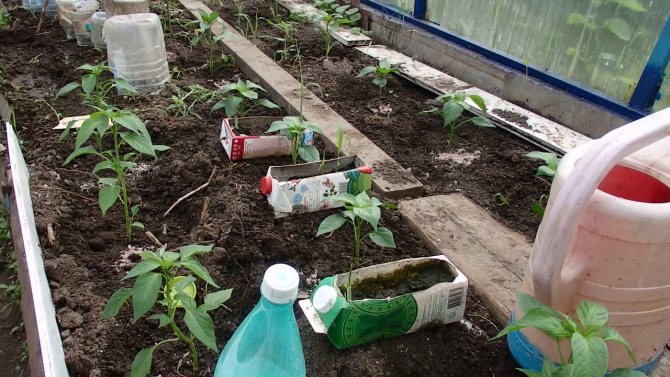

Mineral agrochemicals belong to the third class of hazard. When working with him, you must observe safety precautions, which include:
- protection of hands with gloves;
- the use of a mask that prevents substances from entering the mucous membranes;
- preventing children from playing with granules or calcium nitrate solution.
Store mineral dressing in a closed bag for no more than six months after opening it. The container must be hermetically sealed, as the granules quickly absorb moisture from the air. Children and animals are not allowed to the storage area. To feed the planting of pepper and other crops, strictly follow the indicated dosages, do not prepare a solution "by eye".
The quality and quantity of the pepper harvest directly depends on the dressing. Calcium nitrate allows you to shorten the growing season and extend the fruiting phase, in which growers pick juicy and tasty fruits.
The use of calcium nitrate on different types of soil
Immediately after picking, tomato seedlings need to be fed with calcium nitrate.
Calcium nitrate is essentially an alkaline fertilizer. The fundamental difference from most nitrogen-containing dressings is that it does not acidify the earth. This feature allows the use of calcium nitrate on all types of soil, especially acidic. Calcium neutralizes excess iron, manganese, zinc and other metals that accumulate excessively in acidified soil.
It should be borne in mind that calcium deficiency is aggravated by prolonged heat and drought. In extreme temperature conditions, roots suffer and lose their ability to absorb moisture. Calcium nitrate revitalizes vegetation and ensures normal plant growth.
Calcium nitrate for tomatoes and peppers
Tomatoes and peppers are equally in dire need of calcium nitrate supplementation. In order for the seedlings to feel good in the soil, you need to dig up the fertilizer from the ground in the spring before planting. Application rates - 10 g dry matter per square meter.
It is advisable to make the second feeding liquid 2 weeks after disembarkation... For this take 20 g of calcium nitrate per bucket of water (10 l).
You need to water until the flowers form. Along with calcium, other trace elements should be added in order to maximize the safety of the fruits and preserve the harvest.
You can alternate watering and foliar spraying, which also has a positive effect on plant health. For foliar dressing make a solution of 25 g of calcium nitrate in 1.5 liters of water... The time for spraying should be chosen in the morning or evening to avoid direct sunlight on the leaves.
It should not be allowed:
- draining the solution from the leaves;
- exceeding the concentration of the solution;
- frequent processing of existing fruits.
Important! When the first ovaries appear, foliar feeding should be stopped so that nitrates do not accumulate in the fruits and do not harm human health.
In an unstable climate, feeding tomatoes and peppers will help preserve most of the crop.
And this is what tomatoes look like, which were not treated with calcium nitrate during growth.
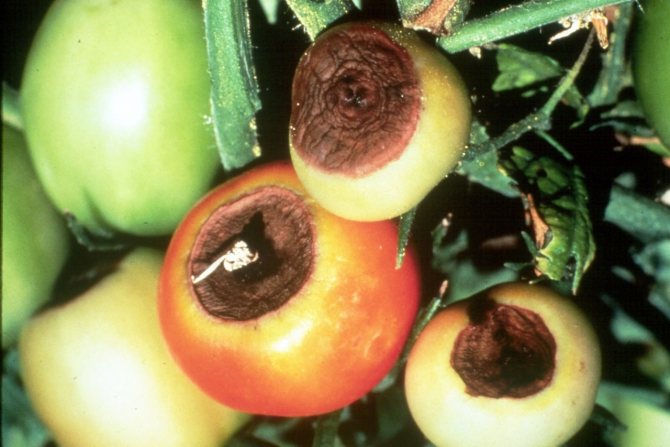

The nature of calcium nitrate
Calcium nitrate is obtained by neutralizing ground limestone with nitric acid. This reaction is characterized by high environmental friendliness. During the production of calcium nitrate, heavy metal salts are not formed, as well as chlorine-containing components.
By the way, instructions on the use of calcium nitrate fertilizer will be presented below in the text.
The main feature of calcium nitrate is the effect of the components on each other. Calcium and nitrogen are synergistic substances. That is, these microelements enhance the mutual action of each other. Thanks to calcium, nitrogen is easily and quickly assimilated by vegetation, and the nitrate form of nitrogen contributes to a more complete assimilation of calcium. The ammonium form of nitrogen, like ammonium nitrate, makes calcium immobile, complicating its entry to the root system.
The second important property of calcium nitrate is that fertilizers for the vegetable garden based on nitrate neutralize the acidic environment. Calcium nitrate base minimizes the concentration of iron and manganese, which provoke soil acidification.
- It makes no sense to add calcium nitrate during the autumn digging of the soil. Under the influence of rains and melt water, nitrogen is washed out of the soil. The remaining calcium will not benefit the plants, since these elements act only in combination.
- When calcium nitrate is added together with fertilizers, which contain sulfates and phosphates, the main elements precipitate into an insoluble sediment, which makes the introduction of such a mixture completely useless. For this reason, calcium, as a rule, is not included in complex fertilizers. Superphosphate, like other phosphorus-containing fertilizers, is not applied simultaneously with calcium nitrate, but a time interval of at least a week is observed (see → application of superphosphate, how to dilute and add to the soil). You should not combine feeding with calcium and potassium nitrate, since calcium in such a combination acts as a potassium antagonist (find out → feeding plants with potassium nitrate). It is also not recommended to mix saltpeter with peat, sawdust, straw.
Description and chemical composition
In the composition of calcium nitrate, the active component is calcium, which occupies 19% of the total amount of substances. It also includes nitrogen, which has a nitrate form, in percentage terms - 13-16%. On the market, the product is presented in the form of granules or white crystals. The drug dissolves well in water, has a high degree of hygroscopicity and, if stored correctly (in a sealed package), may not lose its beneficial properties for a long time.
Calcium nitrate has the formula Ca (NO3) 2. When it gets into the soil, calcium nitrate reacts and practically does not oxidize it, which explains its widespread use.
This remedy nourishes acidic soils better than others. Plants after root and foliar treatment have strong stems, immunity sufficient to resist diseases, and a powerful root system.

